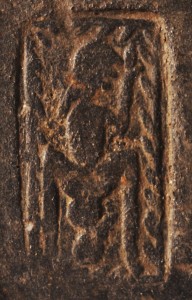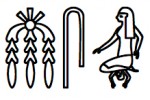 An archaeological excavation at Poggio Colla, an Etruscan site northeast of Florence, has uncovered a fragment of pottery engraved with two images of women giving birth. The fragment is over 2,600 years old which apparently puts it in the running for the oldest depiction of a woman giving birth in western art. According to Open University archaeology professor Phil Perkins, images of childbirth are rare in ancient art. There are later Greek and Roman representations but this depiction is several hundred years older than anything else extant.
An archaeological excavation at Poggio Colla, an Etruscan site northeast of Florence, has uncovered a fragment of pottery engraved with two images of women giving birth. The fragment is over 2,600 years old which apparently puts it in the running for the oldest depiction of a woman giving birth in western art. According to Open University archaeology professor Phil Perkins, images of childbirth are rare in ancient art. There are later Greek and Roman representations but this depiction is several hundred years older than anything else extant.
 (When I first read that I thought it couldn’t be right because not two weeks ago my mom showed me a picture she took at the Temple of Kom Ombo in Egypt of a bas relief depicting a woman mid-childbirth. I looked up the temple dates, though, and Kom Ombo turns out to be Ptolemaic, built in the 2nd and 1st centuries B.C. The Temple of Edfu, which has another childbirth relief, was built between the 3rd and 1st centuries B.C. Dendera’s Temple of Hathor, Egyptian goddess of childbirth, is Ptolemaic too.
(When I first read that I thought it couldn’t be right because not two weeks ago my mom showed me a picture she took at the Temple of Kom Ombo in Egypt of a bas relief depicting a woman mid-childbirth. I looked up the temple dates, though, and Kom Ombo turns out to be Ptolemaic, built in the 2nd and 1st centuries B.C. The Temple of Edfu, which has another childbirth relief, was built between the 3rd and 1st centuries B.C. Dendera’s Temple of Hathor, Egyptian goddess of childbirth, is Ptolemaic too.
 What about the hieroglyph msỉ? It’s the word for childbirth and is a logographic depiction of a woman giving birth. Does pictorial writing not count as an image or is the glyph a later addition to the Egyptian vocabulary? Those aren’t rhetorical questions. I searched but thus far have not found an answer. If y’all know, please to tell.)
What about the hieroglyph msỉ? It’s the word for childbirth and is a logographic depiction of a woman giving birth. Does pictorial writing not count as an image or is the glyph a later addition to the Egyptian vocabulary? Those aren’t rhetorical questions. I searched but thus far have not found an answer. If y’all know, please to tell.)
It was Professor Perkins who identified the fragment as a piece of Etruscan bucchero, a characteristic Etruscan black clay pottery that begins appearing on the archaeological record in the seventh century B.C.
The ceramic fragment is less than 1-3/4 x 1-1/4 inches (4 x 3 cm), from a vessel made of bucchero. Bucchero is a fine, black ceramic material, embellished with stamped and incised decorations, used to make eating and drinking vessels for Etruscan elites. Typically, stamped designs range from abstract geometric motifs to exotic and mythical animals. There are no known Greek or Roman representations of the moment of birth shown as clearly as the Poggio Colla example until more than 500 years later. The fragment dates to about 600 B.C.E. (Before the Common Era).
Because the site at Poggio Colla has produced numerous votive deposits, scholars are certain that for some part of its history it was a sacred spot to a divinity or divinities. The abundance of weaving tools and a stunning deposit of gold jewelry discovered earlier have already suggested to some scholars that the patron divinity may have been female; the discovery of the childbirth scene, because of its uniqueness, adds another piece of evidence to the theory.
The fragment was discovered by William Nutt, agraduate student at the University of Texas at Arlington, who is one of the lucky few selected for the Poggio Colla Field School, a hands-on archaeological plunge into the excavation of one of Etruria’s most fascinating sites, inhabited by Etruscans for almost the entire length of time they are known to have existed, between 700 B.C. and 187 B.C. Nutt is legally blind, very, very lucky and right about now, very, very happy.
“I was very grateful to be accepted to the summer program at Poggio Colla – it was my first archaeological dig,” said Nutt, who is attending UTA under a National Science Foundation fellowship. “I found the artifact at the beginning of my second week there. It was quite dirty, and we weren’t sure what it was until it was cleaned at the onsite lab and identified by Dr. Perkins. It was thrilling to find out that it was so significant. To make a discovery like that, which provides important new information about a culture we know so little about, is exactly what makes archaeology and anthropology so appealing.”